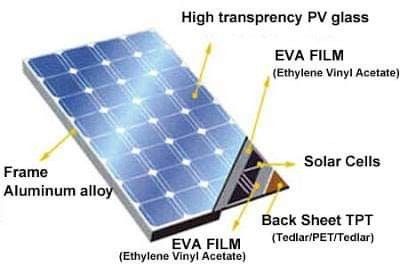Solar cell diagram
A typical diagram of a silicon solar cell, or photovoltaic (PV) cell, reveals a multi-layered semiconductor device designed to convert sunlight directly into electricity. While designs can vary,

Part of Jinko Solar Panel
Grade A Jinko Solar Panel
Solar Cell Diagram Explained
Understand how photovoltaic cells convert sunlight into electricity with our interactive diagram and detailed explanation.
How Solar Cells Work: The Photovoltaic Effect
Solar cells, also known as photovoltaic (PV) cells, are the fundamental building blocks of solar panels. They convert sunlight directly into electricity through the photovoltaic effect—a process where photons from sunlight knock electrons into a higher state of energy, creating an electrical current.
Did you know? The first practical silicon solar cell was created at Bell Laboratories in 1954. Today, solar cells can convert more than 20% of sunlight into electricity.
Interactive Solar Cell Diagram
Explore the different layers of a typical silicon solar cell with our interactive diagram. Hover over each layer to see its name and function.
Anti-Reflective Coating
N-Type Silicon Layer
P-Type Silicon Layer
P-N Junction
Back Contact
Anti-Reflective Coating N-Type Silicon P-Type Silicon P-N Junction
Click on any layer above to learn about its function in the solar cell.
Key Components of a Solar Cell
Each layer in a solar cell has a specific function that contributes to the overall efficiency of the photovoltaic effect:
- 1 Anti-Reflective Coating: Reduces reflection losses, allowing more sunlight to enter the cell.
- 2 N-Type Silicon: Silicon doped with phosphorus, providing extra electrons (negative charge).
- 3 P-Type Silicon: Silicon doped with boron, creating "holes" where electrons can fit (positive charge).
- 4 P-N Junction: The boundary between N-type and P-type silicon where the electric field forms.
- 5 Back Contact: The electrode that completes the electrical circuit.
- 6 Front Contacts: Thin fingers that collect electrons without blocking too much sunlight.
The Science Behind Solar Energy Conversion
When sunlight hits the solar cell, photons with sufficient energy are absorbed by the semiconductor material (typically silicon). This energy excites electrons, knocking them loose from their atoms.
The P-N junction creates an electric field that forces these freed electrons to move in a specific direction—toward the front contacts of the cell. This flow of electrons is an electric current that can be used to power electrical devices.
Types of Solar Cells
While the diagram above represents a typical monocrystalline silicon cell, several other solar cell technologies exist:
Monocrystalline Silicon
Made from single-crystal silicon, these cells offer the highest efficiency (15-22%) but are more expensive to produce.
Polycrystalline Silicon
Made from silicon crystal fragments, these cells have a distinctive blue color and offer slightly lower efficiency (13-16%) at a lower cost.
Thin-Film Solar Cells
Made by depositing one or more thin layers of photovoltaic material onto a substrate. These are less efficient (10-12%) but more flexible and cheaper to produce.
Frequently Asked Questions
What is the lifespan of a solar cell?
Most solar panels are guaranteed to last 25-30 years, but they can continue producing electricity well beyond that period, albeit at reduced efficiency.
How efficient are commercial solar cells?
The efficiency of commercial solar panels typically ranges from 15% to 22%, depending on the technology and quality of materials used.
Can solar cells work on cloudy days?
Yes, solar cells can still generate electricity on cloudy days, though at reduced efficiency. They can capture diffuse sunlight that passes through clouds.
Solar Energy Facts
Solar energy is the most abundant energy resource on Earth — 173,000 terawatts of solar energy strikes the Earth continuously, which is more than 10,000 times the world's total energy use.
Related Topics
- → Solar Panel Installation Guide
- → Calculating Solar Power ROI
- → Latest Solar Cell Technologies
- → Solar Energy Storage Solutions
- → Community Solar Projects
Solar Efficiency Trends
The efficiency of solar cells has improved dramatically over the past decades:
- 1954 6% efficiency
- 1985 14% efficiency
- 2000 17% efficiency
- 2023 22%+ efficiency
